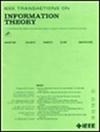防帧码的近最优概率构造
IF 2.9
3区 计算机科学
Q3 COMPUTER SCIENCE, INFORMATION SYSTEMS
引用次数: 0
摘要
防帧代码是一类安全代码,最初是在Boneh和Shaw在数字指纹背景下的开创性工作中引入的。它们可用于提高数字内容的安全性和可信度。设$M_{c,l}(q)$表示长度为l的q元c帧编码的最大基数。基于一个有趣的观察$M_{c,l}(q)$与著名的Erdős匹配猜想在极值集理论中,在2003年,Blackburn提出了一个关于极限$R_{c,l}=\lim _{q\rightarrow \infty }\frac {M_{c,l}(q)}{q^{\lceil l/c \rceil }}$的精确值的开放问题。结合概率方法的几个思想,给出了$M_{c,l}(q)$的一个下界,它与Blackburn的一个上界一起,完全确定了所有固定的$c,l$的$R_{c,l}$,并在充分的一般性下解决了上述开放问题。我们也给出了$M_{c,l}(q)$的改进上界。本文章由计算机程序翻译,如有差异,请以英文原文为准。
Near Optimal Probabilistic Constructions of Frameproof Codes
Frameproof codes are a class of secure codes that were originally introduced in the pioneering work of Boneh and Shaw in the context of digital fingerprinting. They can be used to enhance the security and credibility of digital contents. Let $M_{c,l}(q)$ denote the largest cardinality of a q-ary c-frameproof code with length l. Based on an intriguing observation that relates $M_{c,l}(q)$ to the renowned Erdős Matching Conjecture in extremal set theory, in 2003, Blackburn posed an open problem on the precise value of the limit $R_{c,l}=\lim _{q\rightarrow \infty }\frac {M_{c,l}(q)}{q^{\lceil l/c \rceil }}$ . By combining several ideas from the probabilistic method, we present a lower bound for $M_{c,l}(q)$ , which, together with an upper bound of Blackburn, completely determines $R_{c,l}$ for all fixed $c,l$ , and resolves the above open problem in the full generality. We also present an improved upper bound for $M_{c,l}(q)$ .
求助全文
通过发布文献求助,成功后即可免费获取论文全文。
去求助
来源期刊

IEEE Transactions on Information Theory
工程技术-工程:电子与电气
CiteScore
5.70
自引率
20.00%
发文量
514
审稿时长
12 months
期刊介绍:
The IEEE Transactions on Information Theory is a journal that publishes theoretical and experimental papers concerned with the transmission, processing, and utilization of information. The boundaries of acceptable subject matter are intentionally not sharply delimited. Rather, it is hoped that as the focus of research activity changes, a flexible policy will permit this Transactions to follow suit. Current appropriate topics are best reflected by recent Tables of Contents; they are summarized in the titles of editorial areas that appear on the inside front cover.
 求助内容:
求助内容: 应助结果提醒方式:
应助结果提醒方式:


